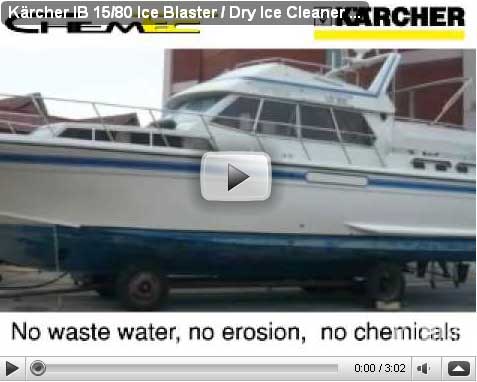There are several different ways to strip antifouling. You can either remove it . by hand using a scraper or apply a chemical stripper, such as Dilunett or AF Interstrip. Neither technique is very pleasant, and both are hard work and time consuming. One alternative is to engage the services of a blast cleaner.
Ice or cryogenic blasting uses dry ice pellets instead of sand or grit. The technology has been around since 1970s and has been used extensively in the aerospace industry, but it has only been in the last 10 or 15 years that ice blasting has been available commercially.
Dry ice is frozen carbon dioxide (CO2) and to make it liquid CO2 stored at high pressure is expanded under normal atmospheric pressure. This cools the liquid, changing its form into snow and ice at a temperature of -79deg C. For blasting use, the dry ice is extruded into 3mm diameter hard pellets.
Dry ice has two other useful features; it sublimates – in other words, it melts and turns into gas rather than a liquid and therefore leaves no trace – and it expands 400 times in volume as it sublimates.
The pellets hit the object to be cleaned (for example, a boats hull) at 300m/sec and ‘shock-freeze’ the antifoul within a fraction of a second. This ‘shock-freeze’ cracks the antifoul and allows the pellets to slip underneath it where they sublimate. The pellets’ expansion then loosens the antifoul and helps remove it. After impact the pellets immediately evaporate back into the atmosphere as a pure gas. The only waste product from ice blasting is the antifouling removed from the hull.
The operator holds the nozzle about 100mm from the side of the hull and covered about a 25mm strip with each sweep. The process is very clean because there is no sand or grit flying about and so there is little to clean up afterwards – just a few litres of antifoul chippings would be on the sheet under a boat once finished.
The result of blasting a hull would be very smooth, even shiny in some areas. In fact on tests it was so smooth that the hull may require keying before a primer or the new antifoul is applied. However, this allowed perfect cleaning and antifoul removal above the waterline even on the gelcoat as its non abrasive, without any damage at all. Using this method on a 34ft Yacht would take around 6-7 hours to complete and use around 500-600kg of pellets.
